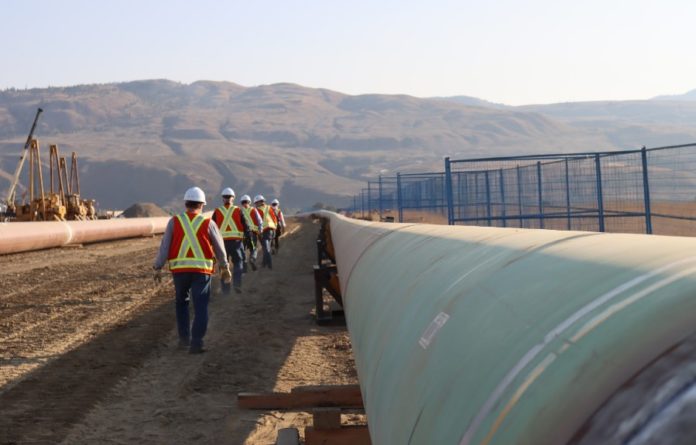Last week, Alberta Premier Danielle Smith announced that the Trans Mountain Pipeline Expansion would finally be getting filled with its first crude oil to be shipped to and eventually exported from BC by Canada Day.
When this happens, the coast of BC will look much different as there will be a massive surge in oil tankers coming through the Salish Sea, which could be detrimental to whale and wildlife populations.
Despite this, a group of environmental advocates say that this announcement should be taken with a grain of salt.
“While it is true that Trans Mountain has been filling some completed sections of the pipeline with oil, as part of the testing process that they must complete before going into operation, there are also still several pipeline segments where construction is not complete,” said Sven Biggs, Canadian Oil and Gas Program Director for Stand.earth.
Issues that could slow operations
He says that most notably, a 2.5 km section called ‘Mountain 3’ near Hope, BC remains unfinished due to several drilling mistakes.
Initially, Trans Mountain tried to drill a 36 inch pipe, but had to go smaller due to their drilling difficulties.
When crews tried drilling a 30 inch wide tunnel for the pipe, they ran into more problems when a section of the pipe broke off in the tunnel and got stuck, according to Biggs.
It took several weeks to get the broken pipe out and a new section had to be custom ordered and shipped from Florida.
In an interview with Financial Post regarding issues encountered in the Mountain 3 section, Trans Mountain’s Chief Financial and Strategy Officer Mark Maki said, “The next few weeks will be very important in terms of being able to enter service in the second quarter.”
Biggs says he interpreted this as meaning that if the next attempt at pulling through the pipe goes poorly, they won’t make their planned start date.
“Note that Maki also says that even if they keep to that schedule the pipeline won’t be operating at full capacity until sometime in 2025, and that he warns that there is likely to be more cost overruns beyond the current $34 billion price tag,” Biggs told Victoria Buzz.
The initial estimate of how much the pipeline would cost was just over $5 billion, but the Government had to bail the project out and buy in at $4.8 billion in 2018 when delays and issues pushed the project way over budget.
That was just the beginning of their budgetary problems, as six years later the cost is looking like it will be around seven times what it was supposed to be and it was initially supposed to be finished several years ago.
Biggs says that in the last couple years, Trans Mountain has announced various predictions of a finish date, or when the pipeline would be going into operation, but missed all of them.
“This is of course part of a much larger pattern of delays with this project which was originally projected to be completed in 2019,” he explained.
Environmental implications around Vancouver Island
Biggs told Victoria Buzz that regardless of when it does become active, when this eventually happens residents of Victoria and southern Vancouver Island are going to see an influx of oil tankers.
“The route the tankers will take is through Boundary Pass and the Haro Strait before passing Victoria on their way to the Strait of Juan de Fuca and the open ocean,” said Biggs.
This map is one created by Trans Mountain showing the route to be followed bi tankers that come and go.

According to Stand.earth, before the Trans Mountain Pipeline Expansion, tanker traffic ranged from 20 to 70 vessels coming and going annually with 50 being an approximate average.
“Once the new pipeline is complete, that will jump to somewhere in the neighbourhood of 408 Aframax tankers a year which each have the capacity to carry 500,000 to 800,000 barrels of oil,” Biggs explained.
“That works out to a little over a 700% increase in oil tanker traffic from this terminal.”
He says the main concern is the possibility of an oil spill in the water, “since it would only take one accident to devastate the Salish Sea for generations to come.”
The other main concern about the increase in traffic is the noise pollution which will impact all marine life, especially the endangered Southern resident killer whales.
According to the World Wildlife Fund, an increase like this could drastically increase the amount of underwater noise.
Whales and other animals in the impacted area will have their ability to communicate via echolocation affected, they’ll have impaired hearing, increased stress which could lead to harmful behavioural changes and a threatened food supply.
For now, the environmentalists remain sceptical that the pipeline will be finished on time, but say they are concerned about what will happen to BC’s coast once it is complete.



